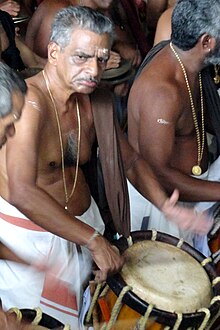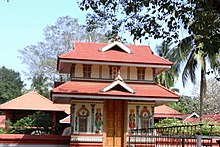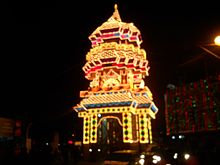Thrissur Pooram is an annual Hindu temple festival held in Kerala, India. It is held at the Vadakkunnathan Temple in Thrissur every year on the Pooram (pronounced [puːɾam]) day - the day when the moon rises with the Pooram star in the Malayalam Calendar month of Medam. It is the largest and most famous of all poorams.
| Thrissur Pooram | |||||
|---|---|---|---|---|---|

Thrissur Pooram
| |||||
| Official name | Thrissur Pooram | ||||
| Observed by | Malayalees, Keralites | ||||
| Type | Hindu temple festival/public holidays in the city of Thrissur | ||||
| Observances | Kudamatam (കുടമാറ്റം), Ilanjithara Melam (ഇലഞ്ഞിത്തറമേളം), Madathil Varavu (മഠത്തില് വരവ്) Fireworks (വെടിക്കെട്ട്) | ||||
| Date | Pooram Nakshatra in the Malayalam Calendar month of Medam | History
Peruvanam Kuttan Marar, leader of 'Chenda' group of Paramekkavu temple
Kizhakkoottu Aniyan Marar, leader of 'Chenda' group of Thiruvambady temple
Kanimangalam Valiyalukkal Bhagavathi Temple
Illumination of Poora Pandal
This made him take the decision to unify the 10 temples situated around Vadakkunnathan Temple and organized the celebration of Thrissur Pooram as a mass festival. He invited temples with their deities to the city of Thrissur to pay obeisance to Lord Vadakkunnathan (Lord Siva), the presiding deity of the Vadakkunnathan Temple. Something unique about this festival is that everything used in the festival is made fresh every year from scratch. There are people who are given the duty to craft the umbrellas and the nettipattam. [4] ParticipantsSakthan Thampuran ordained the temples into two groups, namely "Paramekkavu side" and "Thiruvambady side". These are headed by the principal participants, Paramekkavu Bagavathi Temple at Thrissur Swaraj Round and Thiruvambadi Sri Krishna Temple at Shoranur road. The two temples are hardly 500 metres apart.History
Peruvanam Kuttan Marar, leader of 'Chenda' group of Paramekkavu temple
Kizhakkoottu Aniyan Marar, leader of 'Chenda' group of Thiruvambady temple
Kanimangalam Valiyalukkal Bhagavathi Temple
Illumination of Poora Pandal
This made him take the decision to unify the 10 temples situated around Vadakkunnathan Temple and organized the celebration of Thrissur Pooram as a mass festival. He invited temples with their deities to the city of Thrissur to pay obeisance to Lord Vadakkunnathan (Lord Siva), the presiding deity of the Vadakkunnathan Temple. Something unique about this festival is that everything used in the festival is made fresh every year from scratch. There are people who are given the duty to craft the umbrellas and the nettipattam. [4] ParticipantsSakthan Thampuran ordained the temples into two groups, namely "Paramekkavu side" and "Thiruvambady side". These are headed by the principal participants, Paramekkavu Bagavathi Temple at Thrissur Swaraj Round and Thiruvambadi Sri Krishna Temple at Shoranur road. The two temples are hardly 500 metres apart.Western Group (Thiruvambady side)
Eastern Group (Paramekkavu side)
Flag HoistingThe pooram officially begins from the event of flag hoisting (കൊടിയേറ്റം).[9]The flag hosting ceremony (Kodiyettam) begins seven days before Thrissur Pooram. All the participating temples of Thrissur Pooram are present for the ceremony, and there is a light fireworks to announce the commencement of the festival. Display of fireworks (first round)The first round of pyrotechnics, known as Sample Vedikettu, happens on the fourth day after the flag hoisting of the Pooram. It is a one-hour show presented by Thiruvambady and Paramekkavu Devaswoms. Swaraj Round is venue for this fireworks and starts at 7:15 pm. The display usually has innovative patterns and varieties of fireworks.[10] Even though there were several controversies, permission was granted to conduct Thrissur Pooram in 2017[11]Display of caparisonsThe golden elephant caparison (Nettipattam), elephant accoutrements (Chamayam), ornamental fan made of peacock feathers (Aalavattom), royal fan (Venchamarom), sacred bells and decorative umbrellas are prepared new by Thiruvambady and Paramekkavu Devawsoms separately. Paramekkavu Devaswom exhibits this at the Agrasala in Thrissur City, and the Thiruvambady Devaswom displays the caparisons at the Church Mission Society High School in Thrissur City on the fourth and fifth day before the Pooram. In 2014 and 2015, it was displayed in Kousthubham Hall at Shornur Road[12]Main pooramThe pooram starts at the time of Kanimangalam sasthavu ezhunnellippu in the early morning and is followed by the ezhunnellippu of other six temples. One of the major events in Thrissur Pooram is "Madathil varavu", a panchavadhyam melam, participating more than 200 artists, with instruments such as thimila, madhalam, trumpet, cymbal and edakka. At 2:00, inside the vadakkumnathan temple starts the Ilanjithara melam, consisting of drum, trumpets, pipe and cymbal.The pooram has a good collection of elephants (more than 50) decorated with nettipattam (decorative golden headdress), strikingly crafted Kolam, decorative bells, and ornaments. At the end of the pooram, after the Ilanjithara melam, both Paramekkavu and Thiruvambadi groups enter the temple through the western gate, come out through the southern gate and array themselves face to face in distant places. The two groups in the presence of melam exchange colourful and crafted umbrellas competitively at the top of the elephants, called Kudamattom, which is the eye-catching attraction of the pooram. Later all poorams conclude at Nilapaduthara near western goupuram of Vadakkunnathan Temple. The notable feature of the pooram is its secular nature. All other communities actively participate and make their prominent roles in each and every part of the festival. Most of the pandal works are crafted by the Muslim community. The materials for the umbrellas for Kudamattom are offered by the churches and their members. It is a good sign of secularism which is disintegrating nowadays.[13] Display of fireworks (main round)Thrissur pooram main fireworks (vedikettu / വെടിക്കെട്ട് ) are well renowned all over the country. This amazing display of fireworks is held in the heart of Thrissur city, in Thekkinkadu Maidan.Thiruvambadi and Parmekavu are the main participants in this event. The main fireworks[14] begin in the early morning of the seventh day. Most pooram enthusiasts stay up all night to get a better view of the fireworks. People come from faraway places to watch this amazing display of pyrotechnics. There are four major firework displays in Thrissur Pooram: the 'sample fireworks' on the day before the Pooram, the colorful sparklers that light up the sky (amittu) by both sides on the Pooram evening after the Southward Descent, the most impressive event that mark the peak of Pooram celebrations in the early morning hours, and the final fireworks the following noon after the goddesses bid farewell to each other that mark the end of the pooram. Farewell ceremonyThe seventh day of the pooram is the last day. It is also known as "Pakal Pooram" (പകല് പൂരം). For the people of Thrissur, the pooram is not only a festival but also a time for hospitality. Upacharam Cholli Piriyal (ഉപചാരം ചൊല്ലി പിരിയല്) (farewell ceremony) is the last event held at Swaraj Round. Thiruvambadi Sri Krishna Temple and Paramekkavu Bagavathi Temple idols were taken from the Swaraj Round to their respective temples to mark the end of the Pooram celebrations. The festival ends with display of fireworks known as Pakal Vedikkettu.[15][16]Cultural influencesDespite being a Hindu festival, the Thrissur Pooram is attended by different sections of Kerala society.[17] Several replicas of the festival are held in places in Kerala[18] as well as outside the state.[19][20][21]Thrissur Pooram is considered one of the greatest gatherings in Asia. It has an important place in the tourism map of India, as tourists enjoy the beauty and traditions of this pooram. Rail, bus and air connectivity is excellent in Thrissur, which attracts many foreign tourists to the gala. It is considered as meeting of Devas (ദേവ സംഗമം) | |||




No comments:
Post a Comment